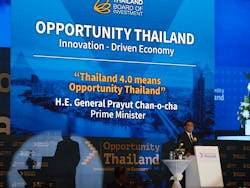2017 is going to be an important year for Thailand’s future. The Thailand 4.0 governmental investment program is likely to change the country and catapult it in a new, advanced era. Thailand is heavily investing in infrastructural projects, manpower, and knowledge. The 4.0 program is promising hundreds of miles of new roads, railways, airports, logistic parks and, yes, even new cities. So what is 4.0 all about? AMT was in Thailand and International Correspondent Marino Boric witnessed the actual situation in Thailand visiting many aviation MRO centers and manufacturers.
Thailand’s Board of Investment BOI kicked off the year 2017 with a mega seminar "Opportunity Thailand 2017" in Bangkok welcoming close to 3,000 investors where it promoted investment opportunities in Thailand and shared with the global community the "Thailand 4.0" model driven by the value-based economy. At the seminar on Feb. 15, 2017, Prime Minister Prayut Chan-o-cha and BOI provided investors with information about Thailand's latest investment incentives.
According to the Thailand 4.0 model, 10 new target industries were identified as the "New Engines of Growth" which likely will transform the country into a regional innovation hub by use of advanced technology, R&D, and human resource development. Some of the new engines of growth industries were included in breakout sessions on new S-curve industries, including aerospace, automation and robotics, and medical devices, with key speakers in each respective sector. The aerospace sector was highlighted with the presentation of the following companies which are already present in Thailand: TurbineAero Inc., Rolls-Royce, Senior Aerospace, and C.S.S.
According to Mrs. Hirunya, Thailand performed very well in terms of investment in 2016; the total investment value by the end of 2016 was 584 billion baht, an increase of 196 percent compared to 2015.
The foreign direct investments (FDI) also expanded, with the investment value of 301 billion baht and the top five countries were Japan, Singapore, China, Hong Kong, and Netherlands. Although the U.S. wasn’t ranked in the top five, it is continuously investing as Thailand is considered a distribution center in the region.
Why Thailand 4.0?
Thailand’s government is promoting “Thailand 4.0” as a new economic model aimed to pull Thailand out of the middle-income trap in which it has been for over a decade. In the beginning of Thailand 3.0 stage, the Thai economy had enjoyed a robust growth which in recent years, has slowed down to 3 and 4 percent only. Thailand’s growth slowed after having reached the middle-income levels. In other words, Thailand is moving on from a country with abundant, cheap, unskilled labor to an innovative high-income country based on “value-based economy.”
What Was Before 4.0?
Thailand has continuously been improving its economic model, starting from “Thailand 1.0,” which focused on the agricultural sector, to light industries with “Thailand 2.0,” where the country utilized cheap labor costs with a focus on domestic productions, through to “Thailand 3.0,” which is focused on more complex industries attracting foreign investments making Thailand a production hub for exports. However, under Thailand 3.0, the country has faced the middle-income trap, growing disparities, and imbalanced development, major concerns which prompted the government to transform Thailand’s economic structure to “Thailand 4.0.”
The Thailand 4.0 development plan is focused on 10 targeted industries, which can be divided into two segments: development of existing industrial sectors and efficient agriculture and biotechnology.
Development of existing industrial sectors should be achieved by adding value through advanced technologies for five industries (Next-Generation Automotive; Smart Electronics; High-Income Tourism, and Medical Tourism. Efficient Agriculture can be achieved by use of biotechnology and food innovation).
Thailand Outlines Aviation Aspirations
The Thailand’s Cabinet recently approved an ambitious 15-year aviation development plan of the Ministry of Transport, which is part of a wider agenda to pursue the Thailand 4.0 plan. In February 2017, the Cabinet endorsed an Aviation Industry Development Plan; Thailand’s Ministry of Transport has set the framework and is offering relevant incentives to grow aircraft maintenance facilities and expand the aircraft parts manufacturing industry including the development of human resources in a plan that goes till 2032.
Image,Table,Graphic
Thailand is competing - in this field - with Singapore, which is an important center for aircraft maintenance and is also the organizer of the region’s major air show for commercial and military aircraft - a sales platform for the region’s spare parts industry serving ASEAN aviation.
Thailand’s Ministry hopes to achieve an ambitious target of establishing an "Aeropolis" to handle the maintenance of regional aircraft and upgrade the country aviation’s industry to Tier 2 (Design & Build) as well as improve human resource skills in the sector.
The Ministry officials say that this incentive could create a THB 10 billion industry and jobs for 7,500, additionally reducing the cost of the annual maintenance for local airlines by THB 6.5 billion over 30 years, Currently, in Thailand 28 factories manufacture spare parts for aircraft and by 2020 this number could rise to over 40. Aviation is one of the 10 targeted industries the government wants to improve.
Thailand’s Infrastructure Investments
Development of the infrastructure is among others, a key element in the Thailand 4.0 aspirations that will create urban centers with strong skill sets and lucrative industries. Here officials speak of megalopolis and smart cities - all things to be created. To connect those new living areas with the production sites (already built, in construction now, and planned ones) a new and efficient infrastructure is needed. Amata group and Hemaraj (WHA Group) are present in Thailand and in the ASEAN region building logistics parks and industrial estates. Under the incentive 4.0 Thailand plans many infrastructural projects which will connect the present and future towns and industrial sites with new motorways, double track rails, high-speed trains, airports and seaports (see map). This all should lead to "smart industry, smart city, and smart people."
Thailand’s Nationwide Airports Upgrade with Help of PPP Program
Thailand’s government approved on Feb. 6 an aviation reform plan that aims to enhance Thailand's status as the region's aviation hub and establish a center for aircraft maintenance, repair, and overhaul (MRO). Under the reform plan, approved by the mini-cabinet chaired by Prime Minister Prayut Chan-o-cha, the private sector will be allowed to invest in the airports via the public-private partnership (PPP) program, while foreign companies will be eligible to handle airport management and hold a share of more than 51 percent in the MRO centers. The public-private partnership program will be allowed for the following 11 city airports: Phrae, Mae Hong Son, Mae Sariang in Mae Hong Son, Tak, Phetchabun, Hua Hin, Nakhon Ratchasima, Pattani, Betong, Chumphon, and U-Tapao.
The 10-year airport development will cover not only the upgrade of the three main international airports but also 36 provincial airports. This action targets the improvement of the country's aviation industry and to make Thailand a key regional aviation hub. This was decided by the mini-cabinet which is the government's strategic national administration committee, chaired by Prime Minister Prayut Chan-o-cha. Under this plan, a total of 39 Thailand airports will be improved to handle an expected 277 million passengers annually within the next 10 years.
Over the next 10 years, Don Mueang airport will handle 40 million passengers, up from 30 million now, with the annual passenger capacity at Suvarnabhumi airport raised to 90 million from 45 million and U-Tapao to 30 million from 3 million passengers. Suvarnabhumi airport expects annual passenger capacity to rise to 45 million by 2025.
Thai and Airbus Sign MoU to Evaluate New Maintenance Facility at U-Tapao International Airport
On March 8, in almost perfect timing and in-line with the above described activities, the news reached us that Airbus Group is considering investing in an aircraft maintenance center in Thailand.
Airbus representatives signed a memorandum of understanding to conduct a feasibility study with Thai International Airways on opening a regional hub for aircraft repair, maintenance, and overhaul at U-Tapao International Airport in province Chon Buri in the south of Thailand.
The new MRO would be one of the most modern and extensive in the Asia-Pacific region. It might become a hub within the ASEAN region offering line and heavy maintenance services for a wide range of aircraft types. A new complex would feature the latest digital technologies to analyze aircraft maintenance data, as well as advanced inspection techniques, including the use of drones to monitor aircraft airframes. Today 40 percent of the aircraft manufactured by Airbus are imported to Asia. Airbus President Fabrice Bregier said that this project will help meet the strong demands of maintenance in the growing Asia-Pacific region, with air fleets in the region tripling to over 15,000 aircraft over the next 20 years.
This project is a part of the Eastern Economic Corridor (EEC) development plan 2017-2021. This will drive Thailand to become the most modern MRO center in the Asia-Pacific, equipped with the best innovation and technology that adheres to international standards, and supports other aviation business industries, bringing the country closer toward Thailand 4.0 as the future gateway to Asia.
About the Author

Marino Boric
Marino Boric graduated with a university degree as an aeronautic engineer, and acquired degrees in business development/trade and commerce and in journalism. He is a civil and military pilot and has built experimental aircraft. As a journalist, he specializes in aviation and propulsion and travels worldwide, flight-testing UL, LSA, Experimental, and certified aircraft. He is writing for U.S., European, and Chinese media companies.
